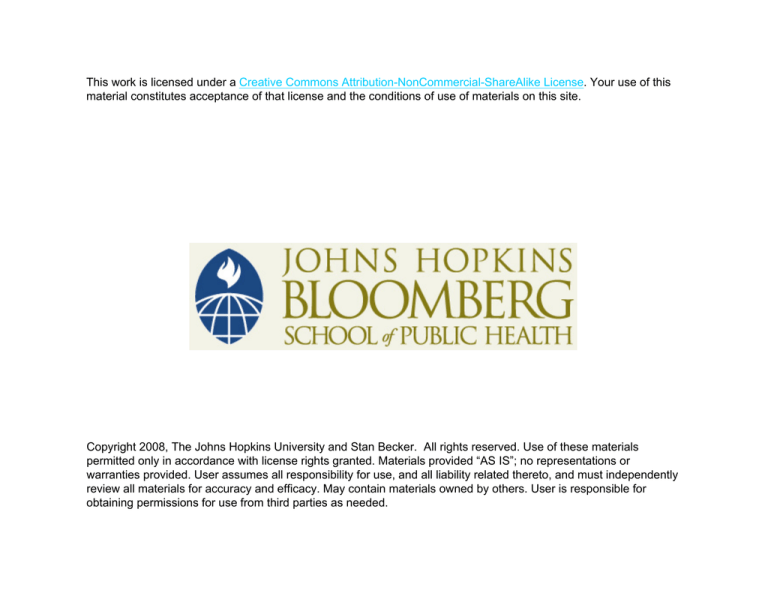
This work is licensed under a Creative Commons Attribution-NonCommercial-ShareAlike License. Your use of this
material constitutes acceptance of that license and the conditions of use of materials on this site.
Copyright 2008, The Johns Hopkins University and Stan Becker. All rights reserved. Use of these materials
permitted only in accordance with license rights granted. Materials provided “AS IS”; no representations or
warranties provided. User assumes all responsibility for use, and all liability related thereto, and must independently
review all materials for accuracy and efficacy. May contain materials owned by others. User is responsible for
obtaining permissions for use from third parties as needed.
Measures of Marriage and
Divorce
Stan Becker, PhD
Bloomberg School of Public Health
Section A
Indicators of Marriage
Marriage
Marriage—Legal union of persons of
opposite sex
The legality of the union may be
established by civil, religious, or other
means as recognized by the laws of each
country
4
Consensual Union
Consensual Union—Establishment of a
marital union without recorded legal
sanction
5
Marriage
Let M
= Number of marriages
P
= Mid-year population
P15+ = Mid-year population age 15
and older
Pm15+ = Number of men age 15 and
older
Pf15+ = W15+ = Number of women age
15 and older
6
Crude Marriage Rate (CMR)
Crude Marriage Rate—Number of
marriages per 1,000 population
M
= ∗ 1000
P
7
General Marriage Rate (GMR)
General Marriage Rate—Number of
marriages per 1,000 population age 15 and
older
=
M
P15 +
∗ 1000
8
Marriage
Important note:
– Most measures of marriage are sexspecific
– In the remaining measures, whenever
the rates are calculated for women, the
same calculations can be done for men
9
General Marriage Rate for
Women and Men
General marriage rate for women (GMRf)
f
M
GMR = f ∗ 1000 ≈ 2 ∗ GMR
P15 +
General marriage rate for men (GMRm)
GMR
m
=
M
m
P15 +
∗ 1000
Note: GMRf ≠ GMRm
10
Exercise
General Marriage Rate
Calculate the general marriage rate for
women and compare it to the general
marriage rate for Brazil (1988) based on
the following data
Brazil, 1988
Number of marriages
:
951 236
Total population 15+
: 92 852 000
Total female population 15+: 46 706 000
You have 15 seconds to calculate the answer. You
may pause the presentation if you need more time.
Source: U.N. Demographic Yearbook, 1989 and 1990
11
Exercise Answer
General Marriage Rate
The correct answers for the general marriage
rates are as follows:
GMR
10.24
GMRf
20.37
Brazil, 1988
Number of marriages
:
951 236
Total population 15+
: 92 852 000
Total female population 15+: 46 706 000
12
Age-Specific Marriage Rate
(ASMR)
ASMR—Number of marriages per 1,000 women
(or men) of age “a”
Ma
=
∗ 1000
Wa
Where Ma = Number of marriages to women
of age “a”
Wa = Mid-year population of women
of age “a”
13
Exercise
Age-Specific Marriage Rate
Calculate the age-specific marriage rate for
women 25–29 for Brazil (1988) based on
the following data:
Brazil, 1988
Number of marriages, women 25-29: 161 086
Female population 25-29:
6 362 000
You have 15 seconds to calculate the answer. You
may pause the presentation if you need more time.
Source: U.N. Demographic Yearbook, 1990
14
Exercise Answer
Age-Specific Marriage Rate
The correct answer for the age-specific
marriage rate for women 25–29 for Brazil
(1988) is as follows:
– 25.32
Brazil, 1988
Number of marriages, women 25-29: 161 086
Female population 25-29:
6 362 000
15
Order-Specific Marriage Rate
(OSMR)
OSMR—Number of order “i” marriages per 1,000
persons age 15 and older with marriage order
“i-1”
i
M
= i−1 ∗ 1000
P15+
Where
Mi
= Number of marriages of order
“i”
Pi-115+= Mid-year population age 15+
with marriage order “i-1”
Continued
16
Order-Specific Marriage Rate
(OSMR)
Note:
– OSMR is normally sex-specific
– It can also be age-specific
OSMR for women
OSMR for men
i
M
∗
1000
i−1
W15+
w
∑ OSMR
i =1
i
M
∗
1000
m,i −1
P15 +
≠ GMR
17
First Order-Specific
Marriage Rate
First order-specific marriage rate is used
for a nuptiality life table
1
M
Where M1
Ps15+
∗ 1000
s
P15 +
= Number of first marriages
= Mid-year population of
never-married (single) persons
Note: Is usually calculated sex-specific
18
Age-Order Specific Marriage
Rate (AOSMR)
Let Mia = Number of marriages of order “i”
to women (or men) of age “a”
Pi-1a = Mid-year population of women
(or men) of age “a” who are at
marriage order “i-1”
Continued
19
Age-Order Specific Marriage
Rate (AOSMR)
AOSMR—Number of marriages of order “i”
per 1,000 women of age “a” who are at
their “i-1th” marriage
=
i
Ma
∗
1000
i-1
Wa
20
Some Relationships
Note that: ∑ AOSMR ≠ ASMR
i
– Since: ASMR =
i
Ma
∗
∑
i-1
i Wa
i-1
Wa
Wa
Also that: ∑ AOSMR ≠ OSMR
a
Mia
Wai-1
– Since: OSMR = ∑
∗
i-1 W
a Wa
15 +
21
Total Marriage Rate (TMR)
Total Marriage Rate—Total number of
marriages a person will have at the end of
his/her marriageable age if he/she follows
the given schedule of marriage
=
65 + M
a
∑
a =15 Pa
Note: Is sex-specific
22
Total First Marriage
Rate (TMFR)
65 + M1
a
TFMR = ∑
a Pa
TFMR ≤ 1.0 for cohort rate,
but period rate can be above 1.0
Note:
TMR
m
> TMR
f
TMR - TFMR = TRMR (Total remarriage rate)
23
Exercise
Total First Marriage Rate (TMFR)
Calculate the total first marriage rate for women
from Brazil (1988) based on the following data
Age
Group
-20
20-24
25-29
30-34
35-39
40-44
45+
1st
Marriages
311 233
346 361
161 086
61 085
29 653
16 503
25 315
Population
32 885 000
6 875 000
6 362 000
5 443 000
4 479 000
3 590 000
12 735 000
You have 15 seconds to calculate the answer. You
may pause the presentation if you need more time.
Source: U.N. Demographic Yearbook, 1990
24
Exercise Answer
Total First Marriage Rate (TMFR)
The correct answer for the age-specific
marriage rate for women 25–29 for Brazil
(1988) is as follows:
– 0.55
Age
Group
-20
20-24
25-29
30-34
35-39
40-44
45+
1st
Marriages
311 233
346 361
161 086
61 085
29 653
16 503
25 315
Population
32 885 000
6 875 000
6 362 000
5 443 000
4 479 000
3 590 000
12 735 000
25
Singulate Mean Age
at Marriage (SMAM)
Estimate of the mean age at first marriage
approximated by indirect method from
cross-sectional data on marital status by
age
– Mean age at marriage of women
marrying before they reach 50
Continued
26
Singulate Mean Age
at Marriage (SMAM)
Basic assumptions:
– The change in the proportion single
from age “x” to age “x+1” is a measure
of the proportion of a birth cohort who
married at that age if no woman dies
between her 15th and 55th birthday
– The risk of marriage has remained
constant (otherwise we estimate the
mean for some average cohort)
Continued
27
Singulate Mean Age
at Marriage (SMAM)
Let Si, Sj = Proportions of women single at
ages i, j, then
54
⎡⎛ 49
⎤
⎞
⎜ ∑ Si + ∑ S j ⎟
⎢
⎥
⎤ ⎜ i= 45
⎡⎛ 49
j=50 ⎟
⎞
∗ 50⎥
⎢⎣⎜⎝ i=∑15Si ∗ 5 ⎟⎠ + 1,500⎥⎦ − ⎢⎜
⎟
2
⎢
⎥
⎟
⎢⎣⎜⎝
⎥⎦
⎠
SMAM =
54
⎛ 49
⎞
⎜ ∑ Si + ∑ S j ⎟
i= 45
j=50 ⎟
100 − ⎜
⎜
⎟
2
⎜
⎟
⎝
⎠
28
Other Measures
Mean and median ages (of first marriage,
of remarriages)
Percent single
Age of groom by age of bride
Duration of marriage
29
Standardization
Most of the marriage measures can and
should be standardized for comparisons
Can be done by direct or indirect method
Used for comparative marriage analyses
Example: Age-standardized first marriage
rate of the U.S. (1960), using England and
Wales (1961) as standard-direct method
30
Age
Group
15-19
20-24
25-29
30-34
35-44
45-64
65+
Total
Male
First
Marriage
Rates U.S.
0.031
0.210
0.190
0.111
0.060
0.019
0.011
Crude = 70.7
Single Male
Population
England
and Wales
1,604,910
989,661
425,643
262,656
373,918
498,549
158,846
4,314,183
Expected
First
Marriages
U.S.A
49,752
207,829
80,872
29,155
22,435
9,472
1,747
401,262
U.S. age-standardized first marriage rate=
401,262 / 4,314,183 x 1,000 = 93
31
Gross Nuptiality Table
Assumes no person dies before passing
through the marriageable ages
Same techniques as in life table
construction
Allows one to determine what proportion of
a cohort of single persons would be
married at various ages assuming that the
marriage rates used continues to prevail
and there is no mortality
32
Net Nuptiality Table
Takes into account mortality as well as
marriage
Indicates the pace at which a group of
single persons is decreased annually by
marriage and death
Continued
33
Net Nuptiality Table
Also gives the probability of a single person
marrying at each year of age according to
the current nuptiality and mortality rates
Provides information on the average age at
marriage
Multiple-decrement life table techniques
are needed
34
Summary
Marital status provides a static
representation of the population with
respect to its marital composition
Measures on marriage focus on the
dynamic aspect
Marriage information are mainly derived
from vital statistics whereas marital status
is primarily analyzed from census and
survey data
Continued
35
Summary
Marriage rates directly measure changes in
population composition characteristics
rather than changes in population size
But if the change in population size is
considered a function of the broader
process of reproduction—which in most
societies occurs through formation of
families—then the rates of family formation
and dissolution are part of population
dynamics
36
Section B
Indicators of Divorce
Divorce
Divorce—Separation of the husband and
wife by a judicial decree which confers on
the parties the right to remarriage
38
Crude Divorce Rate
Crude Divorce Rate—Number of divorces
per 1,000 population
Div
=
∗ 1000
P
Where Div = Number of divorces
P = Mid-year population
39
General Divorce Rate
General Divorce Rate—Number of divorces
per 1,000 persons age 15 and more
Div
=
∗ 1000
P15 +
Where Div
P15+
= Number of divorces
= Mid-year population 15 and
older
40
Exercise
Crude and General Divorce Rates
Calculate the crude divorce rate and the
general divorce rate for Brazil (1988) based
on the following data:
Brazil, 1988
Number of divorces :
33,437
Total population 15+ : 92,852,000
Total population
: 144,428,000
You have 15 seconds to calculate the answer. You
may pause the presentation if you need more time.
Source: U.N. Demographic Yearbook, 1990
41
Exercise Answer
Crude and General Divorce Rates
The correct answers for the crude divorce rate for
Brazil (1988) are as follows:
– Crude Divorce Rate = 6.45 divorces per
1,000 population
– General Divorce Rate = 10.03 divorces
per 1,000 persons age 15+
Brazil, 1988
Number of divorces :
33,437
Total population 15+ : 92,852,000
Total population
: 144,428,000
42
Divorce Rate Among Married
Couples
Divorce Rate Among Married Couples—
Number of divorces per 1,000 married
persons
Div
=
∗ 1000
Pm
Where Pm = Mid-year population of
married persons
Note: Can be sex-specific
43
Age-Specific Divorce Rate
Age-Specific Divorce Rate—Number of
divorces per 1,000 women (or men) of age
“a”
f
Div a
= f ∗ 1000
Pa
Where Divfa = Number of divorces by
women age “a”
Pfa = Mid-year population of
women age “a”
44
Exercise
Age-Specific Divorce Rates
Calculate the age-specific divorce rates for
women 30–34 and 40–44 for Brazil (1988)
based on the following data
Brazil, 1988
Age Group
30–34
40–44
Divorces
6,689
4,825
Population
5,443,000
3,590,000
You have 15 seconds to calculate the answer. You
may pause the presentation if you need more time.
Source: U.N. Demographic Yearbook, 1990
45
Exercise Answer
Age-Specific Divorce Rates
The correct answers for the age-specific divorce
rate are as follows:
– 1.23 divorces per 1,000 women 30–34
– 1.34 divorces per 1,000 women 40–44
Brazil, 1988
Age group
30–34
40–44
Divorces
6,689
4,825
Population
5,443,000
3,590,000
46
Duration-Specific Divorce Rate
Let Divd
Pdmar
= Number of divorces to
persons who have been
married for a duration d
= Mid-year married population
of persons who have been
married for a duration d
Continued
47
Duration-Specific Divorce Rate
Duration-Specific Divorce Rate—Number of
divorces per 1,000 persons who have been
married for a duration “d”
Div d
= d ∗ 1000
Pmar
48
Order-Specific Divorce Rate
Let Divi
Pimar
Pi-1div
= Number of divorces of order
“i”
= Mid-year married population
of persons who have been
married “i” times
= Mid-year population of
persons divorced “i-1” times
Continued
49
Order-Specific Divorce Rate
Order-Specific Divorce Rate—Number of
divorces of order “i” per 1,000 persons who
have been married “i” times
Div
i
= i ∗ 1000
Pmar
Note: It may be hard to get the
denominator
Continued
50
Order-Specific Divorce Rate
Alternatively:
– Number of divorces of order “i” per
1,000 persons who have divorced “i-1”
times
i
Div
= i-1 ∗ 1000
Pdiv
51
Standardization of
Divorce Rates
Crude and general divorce rates can be
standardized
Can be done by direct or indirect method
Used for comparative divorce analyses
52
Comparison of Crude Annual Divorce Rates
Adapted from Joshua R. Goldstein, The Leveling of Divorce in the
United States, Demography, Volume 36 (3), August 1999
53
Estimated Marital Duration
Effects for Divorce
Adapted from Joshua R. Goldstein, The Leveling of Divorce in the
United States, Demography, Volume 36 (3), August 1999
54
U.S. Annual Divorce Rate
Adapted from Andrew J. Cherlin, Marriage, Divorce, Remarriage.
Harvard University Press, 1992
55
Proportion of Marriages that
Will End in Divorce
Adapted from Andrew J. Cherlin, Marriage, Divorce, Remarriage.
Harvard University Press, 1992
56
Summary
Measures on marriage and divorce focus on
the dynamic aspect
Divorce information is mainly derived from
vital statistics
Divorce rates measure changes in
population composition characteristics
rather than changes in population size
57






